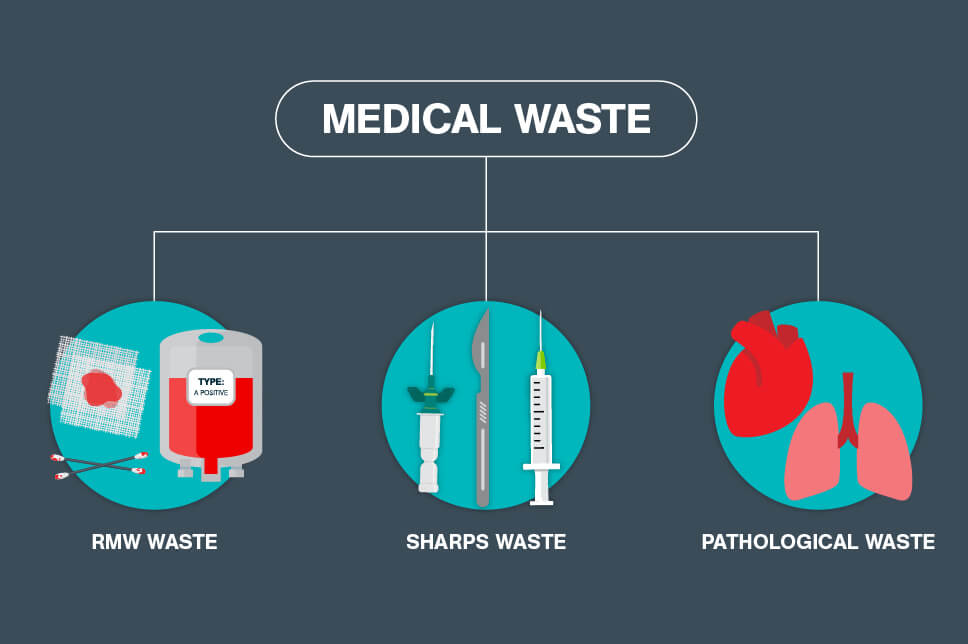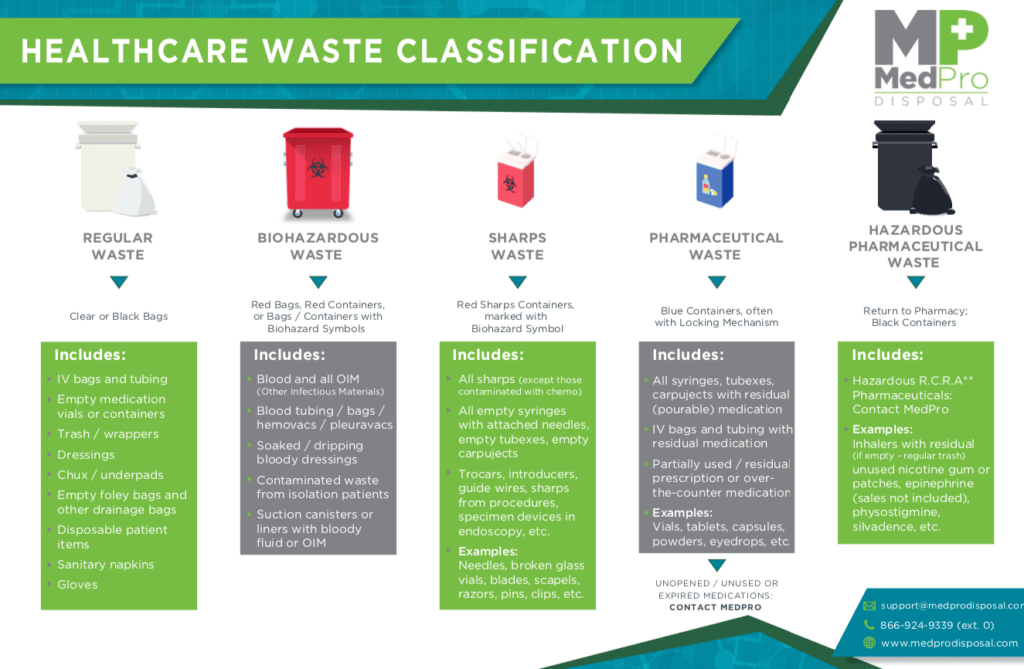Your Ally in Medical Waste Removal: Professional Service with Environmental Care
Wiki Article
Ideal Practices for Medical Waste Management
Medical waste monitoring is a vital aspect of medical care facilities' operations to guarantee the safety of people, personnel, and the environment. Applying ideal methods in clinical waste administration is important to minimize the threats associated with dangerous waste.Partition and Classification
In the field of medical waste monitoring, appropriate partition and categorization are important techniques for guaranteeing the secure and effective disposal of healthcare-related products. Medical waste is created from various resources, consisting of health centers, clinics, research laboratories, and other health care facilities. It includes a vast array of items, such as needles, syringes, bandages, handwear covers, and pharmaceutical waste.Segregation involves the systematic separation of various kinds of clinical waste based on their characteristics and prospective risks. Sharps waste, such as needles and blades, ought to be placed in puncture-resistant containers to avoid injuries and the spread of infectious illness.
Categorization is the process of classifying medical waste into various groups based upon its prospective dangers. WasteX Medical Waste Disposal. These groups might consist of contagious waste, contaminated materials, pharmaceutical waste, and basic waste. By classifying waste, healthcare centers can establish the proper disposal methods and ensure conformity with regional guidelines and standards
Appropriate segregation and classification of medical waste not just secure the health and wellness and safety of medical care workers and the public however additionally add to the overall effectiveness and effectiveness of waste monitoring. It decreases the threat of accidents, decreases environmental influences, and promotes liable waste disposal methods.
Correct Storage and Classifying
To make sure the efficient and risk-free disposal of clinical waste, healthcare centers need to comply with correct storage and labeling techniques. Proper storage space and labeling play a critical role in preserving the honesty of medical waste administration systems and shielding the health and wellness of medical care workers, individuals, and the public.When it comes to storage, it is important to have marked areas particularly created for various kinds of medical waste. These areas must be safe and secure, well-ventilated, and equipped with suitable containers that meet regulative requirements. Partition and classification of waste need to also be taken into account to prevent cross-contamination and prospective hazards.
Additionally, proper labeling is vital for effective waste administration. Each container must be plainly classified with the ideal symbols, color-coding, and information about the waste it includes. Labels must consist of information such as the kind of waste, day of collection, and the name of the generator. This makes certain that all individuals taking care of the waste can easily recognize and manage it correctly.
Routine monitoring and inspection of storage space locations and containers are necessary to determine any issues or infractions. Personnel ought to be educated on appropriate storage and labeling techniques, stressing the value of compliance with methods and policies.
Safe Transportation and Handling
Guaranteeing the proper and secure transport and handling of medical waste is crucial for keeping the stability of waste administration systems and guarding the health and wellness of all entailed. Medical waste, which consists of products contaminated with transmittable products, pharmaceuticals, and various other harmful substances, need to be delivered in a manner that stops leaks, spills, and prospective contamination.It is crucial to use puncture-resistant and watertight containers that are especially made for clinical waste. Additionally, waste ought to be segregated based on its nature and type to stop cross-contamination.
Throughout transportation, it is essential to make sure that waste containers are firmly attached and saved in a secure manner. Vehicles used for carrying medical waste must be furnished with ideal safety and security attributes, such as spill control systems, to decrease the threat of any kind of spills or leakages (medical waste removal service). Chauffeurs ought to get training on proper handling and emergency response procedures to properly resolve any kind of unpredicted occurrences
In addition, the transport and handling of clinical waste need to abide by all appropriate policies and guidelines set forth by neighborhood, state, and government authorities. Routine evaluations and audits ought to be conducted to analyze conformity and determine any locations for enhancement.

Conformity With Regulatory Standards
Maintaining conformity with regulative guidelines is essential for reliable medical waste management. These standards are established to shield public wellness and the setting by making sure that medical waste is effectively taken care of, dealt with, and disposed of. medical waste disposal service. Compliance with governing guidelines helps to stop the spread of infectious diseases, lessen prospective hazards, and minimize the overall influence of medical waste on the settingTo accomplish conformity, health care centers must stay notified regarding the certain policies controling medical waste administration in their territory. These policies might differ from country to nation, and even within various states or regions. It is necessary for medical care facilities to have a thorough understanding of these guidelines and to carry out appropriate methods and methods to guarantee conformity.
One key element of conformity is the correct segregation and labeling of various types of clinical waste. This consists of dividing sharps from other waste, in addition to classifying waste based on its prospective threats. Medical care facilities should additionally guarantee that medical waste is kept in ideal containers and that these containers are effectively classified and sealed.
Additionally, conformity with regulative standards calls for healthcare facilities to establish correct training and education and learning programs for team member associated with medical waste management - WasteX Medical Waste Disposal. This consists of supplying training on waste partition, managing, and disposal treatments, along with the correct usage of personal protective tools
Normal tracking and audits are also important to make certain ongoing conformity with governing standards. This includes conducting normal examinations of waste storage space areas, documenting waste monitoring procedures, and maintaining records of waste disposal.
Reliable Disposal Techniques
Healthcare centers have to utilize effective disposal methods for appropriate administration of medical waste - WasteX Medical Waste Disposal. Incorrect disposal of clinical waste can present serious wellness and environmental threats. There are several approaches that can be utilized to review properly take care of medical waste, ensuring the security of healthcare workers, people, and the publicOne generally used approach is incineration. Incinerators can safely melt medical waste at high temperature levels, reducing the volume and damaging any possibly unsafe microorganisms. Nonetheless, incineration can be costly and might launch hazardous toxins right into the air if not appropriately regulated.
One more approach is autoclaving, which involves subjecting the waste to high-pressure heavy steam. This procedure kills microorganisms, viruses, and various other microorganisms, providing the waste safe for disposal in normal waste streams. Autoclaving is a environmentally friendly and reliable approach, but it needs customized equipment and qualified employees.
Chemical sanitation is also used in many cases, where fluid chemicals are used to the waste to disinfect it. This technique is less generally made use of due to issues regarding the performance of chemical sanitation and the potential for chemical residues to pollute the setting.
In addition to these methods, health care facilities must additionally apply proper segregation, packaging, and labeling of medical waste to ensure its safe handling and disposal. Regular training and education of staff on proper waste administration methods are crucial to maintaining effective disposal methods.
Conclusion

Medical waste management is an essential element of healthcare centers' operations to make certain the security of patients, team, and the environment. Applying finest techniques in medical waste monitoring is vital to minimize the threats associated with unsafe waste. These classifications might include transmittable waste, dangerous waste, pharmaceutical waste, and basic waste.In final thought, applying finest practices for clinical waste monitoring is vital for guaranteeing the safety and security of healthcare employees, people, and the environment. By effectively segregating and classifying waste, saving and classifying it correctly, making sure secure transportation and handling, abiding with regulatory standards, and employing efficient disposal approaches, healthcare centers can efficiently handle and decrease the risks connected with clinical waste.
Report this wiki page